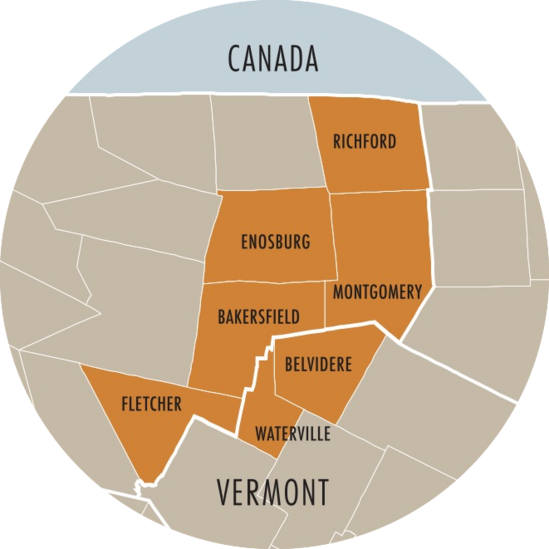Our Forests

In Vermont, our forests define our cultural heritage and act as an economic engine, contributing an estimated $3.4 billion annually to the Vermont economy in forest-based manufacturing and recreation. We depend on our working forests for their material contributions of timber, veneer, pulpwood, firewood, chips, pellets, and maple syrup, as well as for the values and ecosystem services forests provide which are harder to monetize, such as clean air, clean water, and carbon sequestration. Our forests, which cover more than three-quarters of the State, also provide critical habitat for wide-ranging mammals and the greatest diversity of breeding bird species in the United States.


The Cold Hollow Mountains
The Cold Hollow Mountains stretch across seven towns in northern Vermont, making up the tip of the Green Mountain ridge line. This area extends from the towns of Fletcher, Waterville and Belvidere in the south up to the Canadian border and the towns of Bakersfield, Enosburgh, Montgomery, and Richford. We informally refer to the area that these seven towns encompass as the Cold Hollow to Canada (CHC) region.
A Crucial Nexus within the Northern Forest
The Cold Hollow Mountains are part of the largest intact temperate forest left in the world: the Northern Forest, stretching across the northeastern United States and southeastern Canada. From Massachusetts to Quebec, the Northern Forest encompasses nearly 82 million acres and is inhabited by 470 vertebrate species, 2,700 plant species, and 5 million people.
The forests of the CHC region lie at a crucial nexus for wildlife traveling across the greater Northern Forest. This wildlife linkage, known as the Northern Green Mountains Priority Linkage, runs from the northern Green Mountains in the United States to the Sutton Range in Canada, and has been identified by Two Countries, One Forest as one of the top six wildlife connectivity linkages in the Northern Forest. The functional integrity of the entire Northern Forest can be maintained by conserving forest blocks and connectivity in these six linkages.

Critical for Wildlife
As a regional crossroad, the ridge lines and valleys in the Cold Hollow Mountains provide crucial habitat links for wildlife from across the northeast. From New York to Nova Scotia, wide-ranging mammals are connected via an elaborate habitat network that allows for the flow of genetic diversity and keeps populations strong by enabling wildlife such as black bear, moose, bobcat, and fisher to travel as far as they need to.
The Cold Hollow Mountains, as part of the Northern Forest, are also home to the greatest diversity of breeding bird species in the continental United States. Species like the Black-throated Blue Warbler, Canada Warbler, Wood Thrush, Bicknell's Thrush, and others, have in some cases 90% of their global population breeding in this region.
We Are Losing Forests Now
Vermont is now losing forest cover for the first time since the mid-1800s. Today, with increased forest fragmentation caused by development, we risk losing the important contributions that working forests make to our economy, our ecology, and our culture. Furthermore, degradation of the Northern Forest's connecting landscape throughout the CHC region could isolate forests lying to the north and south. Because of this, protecting forests throughout the Cold Hollow Mountains is key to achieving our vision of a resilient and connected ecosystem across the entire Northern Forest.
Conservation
With only 20% of the landscape throughout the CHC region currently protected through conservation, we have a grave responsibility and a narrow opportunity of time to protect the integrity of our forests. Keeping forests as forests through stewardship, conservation, and community empowerment is central to CHC’s mission and vision.
Curious to learn more?
Check out our forestland conservation priorities!
Photo by Jenny Goyne and Map by Trombulak, S.C., M.G. Anderson, R.F. Baldwin, K. Beazley, J.C. Ray, C. Reining, G. Woolmer, C. Bettigole, G. Forbes, & L. Gratton. 2008. The Northern Appalachian/Acadian Ecoregion: Priority Locations For Conservation Action. Two Countries, One Forest Special Report No. 1.